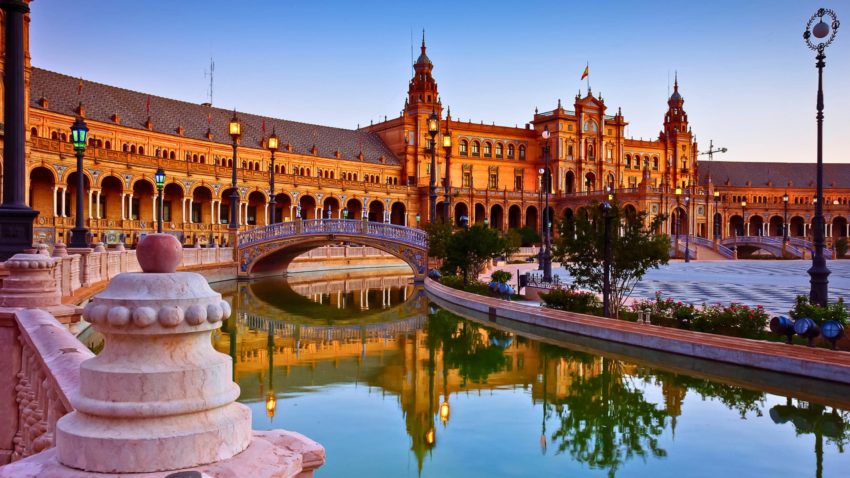Spain is a country rich in history and culture, and many of its ancient walls, which are not to be missed if you love history, are silent witnesses to a past full of conquests, battles and political changes. These defensive structures, which once protected entire cities, now stand as impressive monuments that tell stories of times gone by. In this blog, we explore “15 Walls of Spain You Can’t Miss”, highlighting the country’s most iconic and fascinating.
From imposing Roman walls to medieval and Renaissance fortifications, each of these walls offers a unique glimpse into Spain’s historical and architectural evolution. Get ready for a journey through time, discovering the wonders these ancient defences have to offer.
Walls of Spain: Discover the 15 Walls of Spain you can’t miss. From complete constructions to small remains.
Walls of Spain: TOP 15
1. Walls of Ávila
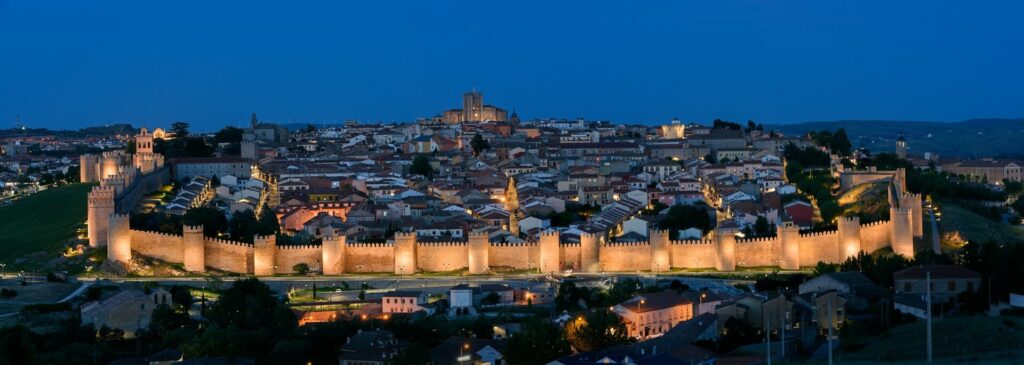
The Walls of Avila, built in the 11th century, are one of the most impressive examples of medieval fortifications in Spain. With their 2.5 kilometres in length and 87 semicircular towers, they completely surround the old part of the city. These walls of Spain are a testament to the power and importance of Ávila during the Reconquest. They are in an exceptional state of conservation, allowing visitors to walk along their ramparts and enjoy breathtaking panoramic views. Declared a World Heritage Site by UNESCO, the Walls of Ávila are an essential destination for lovers of history and architecture.
Its imposing architecture and majesty, with up to 88 towers (87 after the construction of a chapel next to the cathedral), make it the most important of the city walls of Spain that you cannot miss.
The Roman origin hidden under the medieval stones: Although the wall of Avila is known for its medieval construction, some studies suggest that under the impressive stones of today there are remains of an earlier Roman wall. This indicates that the city has been fortified since ancient times, which adds even more historical value to the present wall. These Roman remains reinforce the importance of this place, making it one of those walls not to be missed for those who want to explore the deep history of Spain.
Legends of the Patron Saint: Legend has it that during the construction of the wall, San Segundo, patron saint of Ávila, helped the workers in a miraculous way. It is said that at night, stones would appear in places where no man could have moved them on his own. These stories are part of the mystical charm of Ávila and make this wall a special place. It is definitely one of those walls of Spain that you cannot miss, as its history combines the tangible with the legendary.
The mystery of the Puerta del Alcázar: Among the various gates in the wall of Ávila, the Puerta del Alcázar stands out not only for its monumental architecture, but also for the rumours of secret tunnels that would have connected the city with the outside world in times of war. Although no hard evidence has ever been found, this type of story continues to fuel the mystery surrounding this place. This is one of the details that make the city walls of Ávila one of the walls of Spain you should not miss if you visit Spain.
2. Walls of Lugo
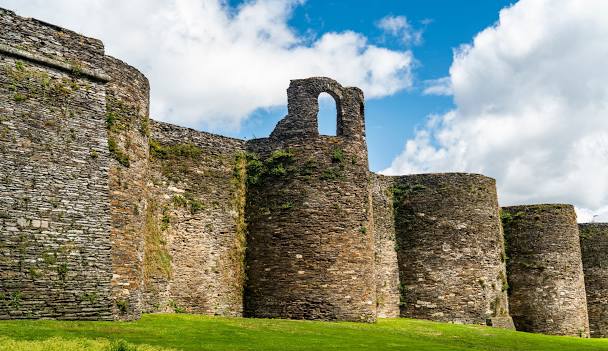
The Walls of Lugo, built in the 3rd century during the Roman Empire, are the only complete Roman walls of Spain still standing in their entirety. With a length of more than 2 kilometres and 71 towers, these unmissable walls of Spain surround the old town of Lugo and have been declared a World Heritage Site by UNESCO. Their impressive height and thickness reflect advanced Roman engineering. Today, visitors can walk along the top of the walls, enjoying a unique view of the city and its surroundings.
The mythical gates of the wall: Originally, the wall of Lugo had five access gates, although today it has ten. Among them, the Santiago Gate stands out, known for being aligned with the city’s cathedral. According to legends, this gate was built in honour of the apostle St. James, and it is believed that it was a crossing point for pilgrims on their way to Compostela. This detail adds a cultural and spiritual attraction to the wall, consolidating it as one of those walls of Spain you can’t miss.
A walk through history: One of the most fascinating experiences offered by the walls of Spain of Lugo is the possibility of walking on top of them, following the same steps as the Roman sentries did almost two millennia ago. The walk affords a unique panoramic view of the city and is an opportunity to experience history at first hand. Moreover, it is one of the few examples in the world where you can do this. This is another reason why these are walls of Spain you cannot miss on your visit to Galicia.
3. Walls of Segovia
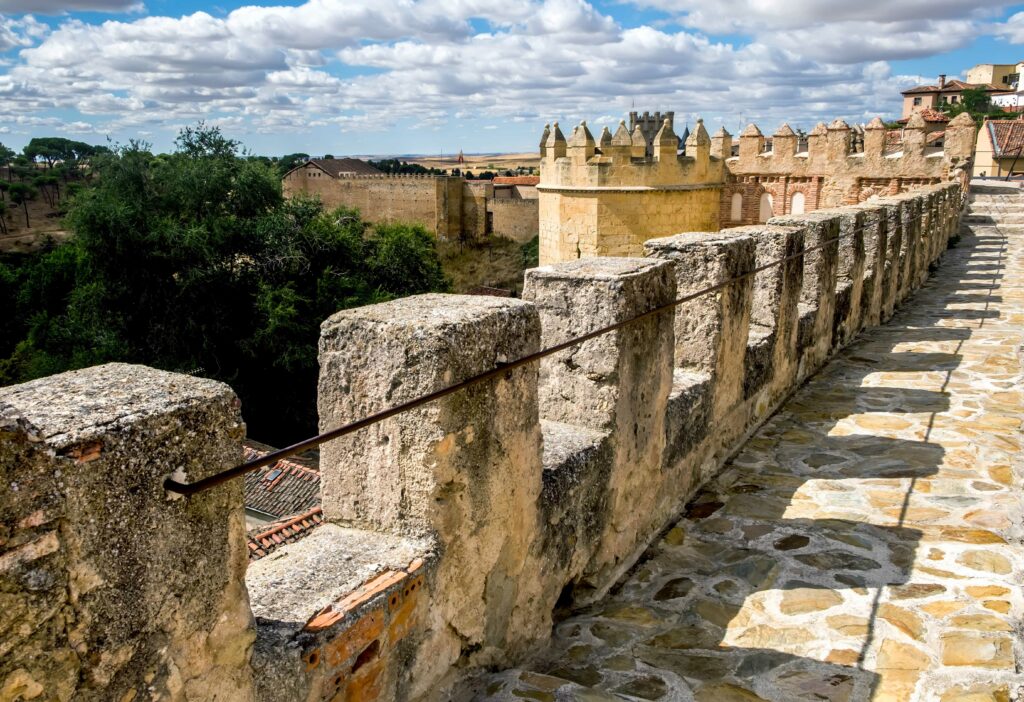
The Walls of Segovia, built in the 11th century, are one of the most important fortifications in the city. Originally built on a Roman base, these unmissable medieval walls protected the city from invasions and attacks. With a length of more than 3 kilometres and several historic gates, such as the Puerta de San Andrés, the walls of Spain offer a breathtaking view of Segovia Cathedral and the Alcázar of Segovia. Although some parts have been restored, the walls retain their authenticity and are a testament to the city’s defensive past.
The legend of the gate of San Andrés: The gate of San Andrés, one of the most important gates in the walls of Segovia, is surrounded by stories that link it to historical figures such as Queen Isabella the Catholic, who supposedly used this entrance during her visits to the city. This gate, along with others such as Santiago, make the walls of Segovia a place full of myths and curiosities, walls of Spain that you cannot miss for their historical and cultural value.
Unique panoramic views from the top of the walls of Spain: One of the greatest attractions of the walls of Segovia is the possibility of accessing some of its sections and enjoying unparalleled views of the city, including the famous Alcazar and the cathedral. In addition to its defensive function, this wall offers a unique tourist experience, making it an ideal destination for those who are looking for walls of Spain that are not to be missed on their journey through Spain’s medieval history.
4. Walls of Toledo
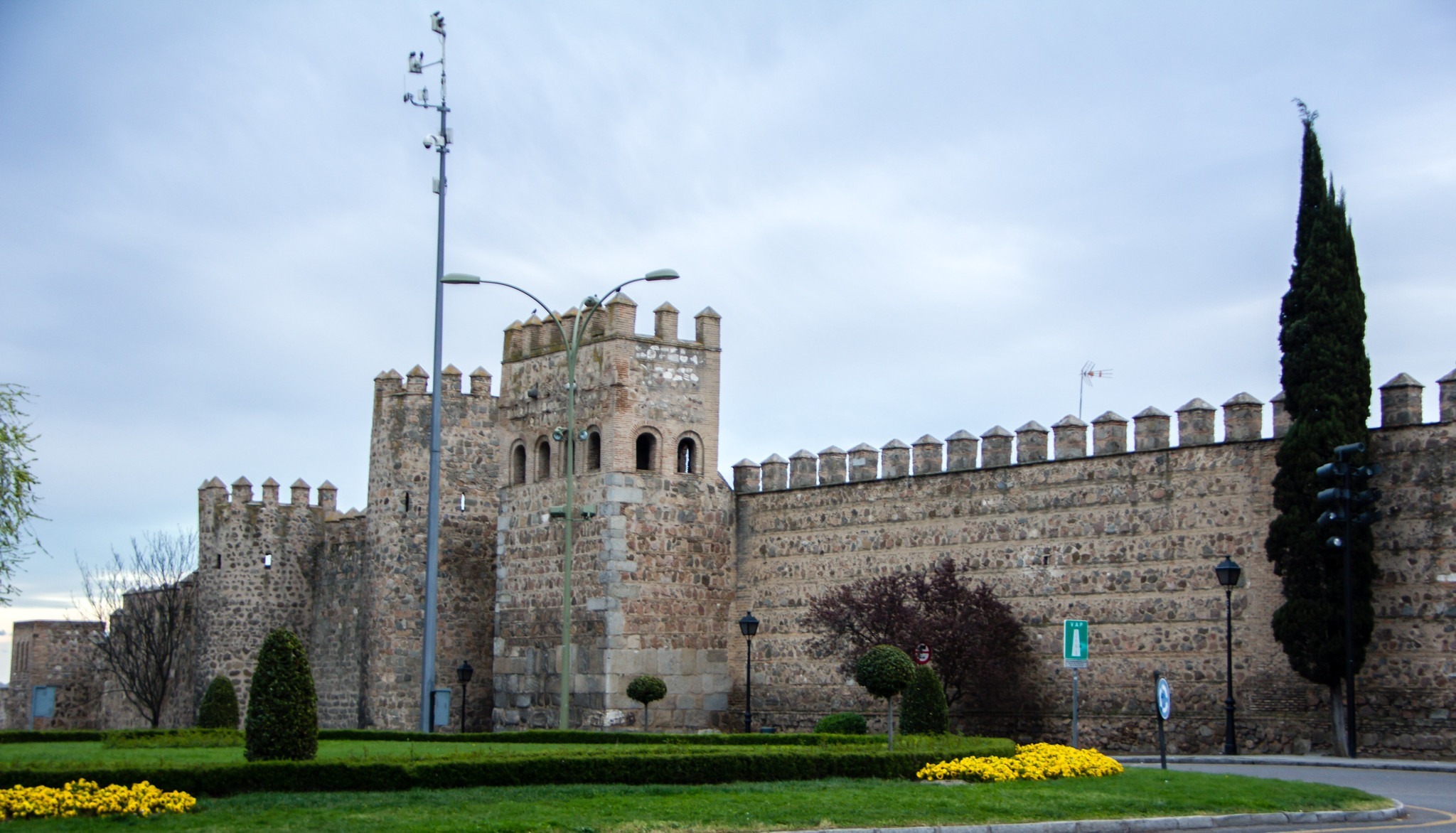
Dating back to the Roman period and having been extended and reinforced by Visigoths, Arabs and Christians, the Walls of Toledo are a symbol of the city’s rich multicultural history. These fortifications, which enclose the old town of Toledo, feature numerous historic gates and towers, such as the Puerta de Bisagra and the Puerta del Sol. The walls of Spain offer a breathtaking panoramic view of the Tagus River and the surrounding area. Toledo, known as the “City of the Three Cultures”, finds in them a reflection of its historical and cultural legacy, so now you know another of the walls of Spain you cannot miss if you really like Spanish history.
The Bisagra Gate, symbol of power and welcome: Among the many gates that make up the wall, the Bisagra Gate is undoubtedly the most majestic. This impressive entrance was remodelled during the Christian era and is considered one of the emblems of Toledo. Anyone arriving in the city will come across this imposing arch that marks the entrance to a walled enclosure full of history. If you visit Toledo, you will be greeted by this imposing monument.
The Cambrón Gate and the secrets of the Monastery of San Juan de los Reyes: The Cambrón Gate, located to the west of the city, takes its name from the cambrón plant that grew in the area. This gate gave access to the monastery of San Juan de los Reyes, which Isabella the Catholic ordered to be built after the Battle of Toro.
According to legend, the monks of the monastery hid secrets in underground tunnels that connected with the wall. Although the existence of these tunnels has not been proven, the idea of an underground network running through Toledo continues to capture the imagination of visitors. The walls that you can’t miss here not only protect, but also hide mysteries.
5. Pamplona City Walls
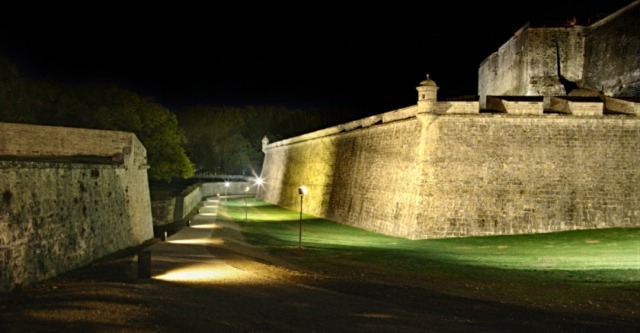
The Walls of Pamplona, built between the 16th and 18th centuries, are one of the best-preserved fortifications in Spain. These Renaissance walls of Spain were designed to resist artillery and surround a large part of the old quarter of the city. With a length of more than 5 kilometres, they include several monumental gates, such as the Puerta de Francia. So if you visit Pamplona, make time to enjoy these unmissable walls of Spain, which have been restored and now offer a green space where visitors can stroll and enjoy Pamplona’s military history.
6. Walls of Ibiza
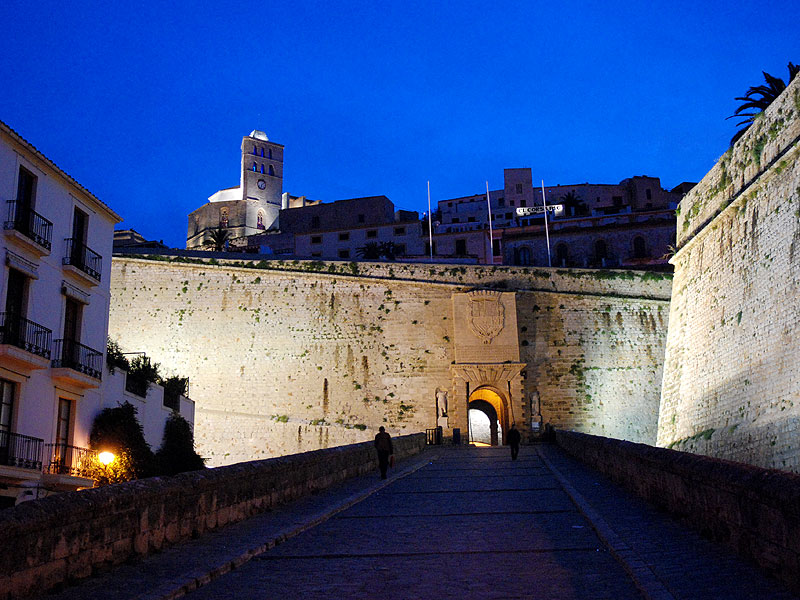
The Walls of Ibiza, built in the 16th century under the reign of Philip II, are an outstanding example of Renaissance fortification in the Mediterranean. Declared a World Heritage Site by UNESCO, these walls surround the old quarter of Ibiza, known as Dalt Vila.
With seven bastions and several historic gates, such as the Portal de Ses Taules, the walls of Spain offer panoramic views of the port and the city. Ibiza’s fortifications are a testament to the strategic importance of the island during the time of the pirate invasions and mark it as one of the main walls not to be missed. Although you might not expect Ibiza to have one of the island’s must-see walls, it surprises us once again.
7. Tarragona Walls
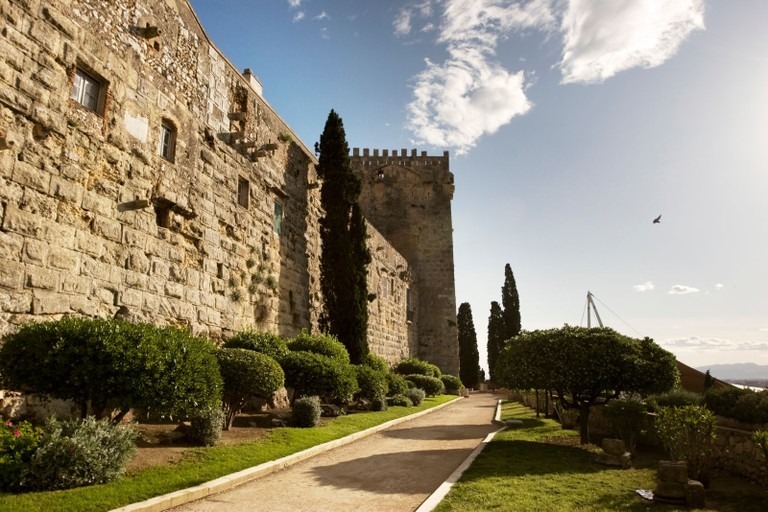
The Walls of Tarragona, of Roman origin and dating back to the 3rd century BC, are one of the oldest fortifications on the list. These unmissable walls of Spain, which originally surrounded the city of Tarraco, have been partially restored and conserve a large part of their original structure. Declared a UNESCO World Heritage Site, the walls offer a fascinating insight into Roman military engineering. Visitors can walk along the archaeological walkway, enjoying breathtaking views and exploring the historical remains of this ancient Roman city.
8. Cuenca City Walls
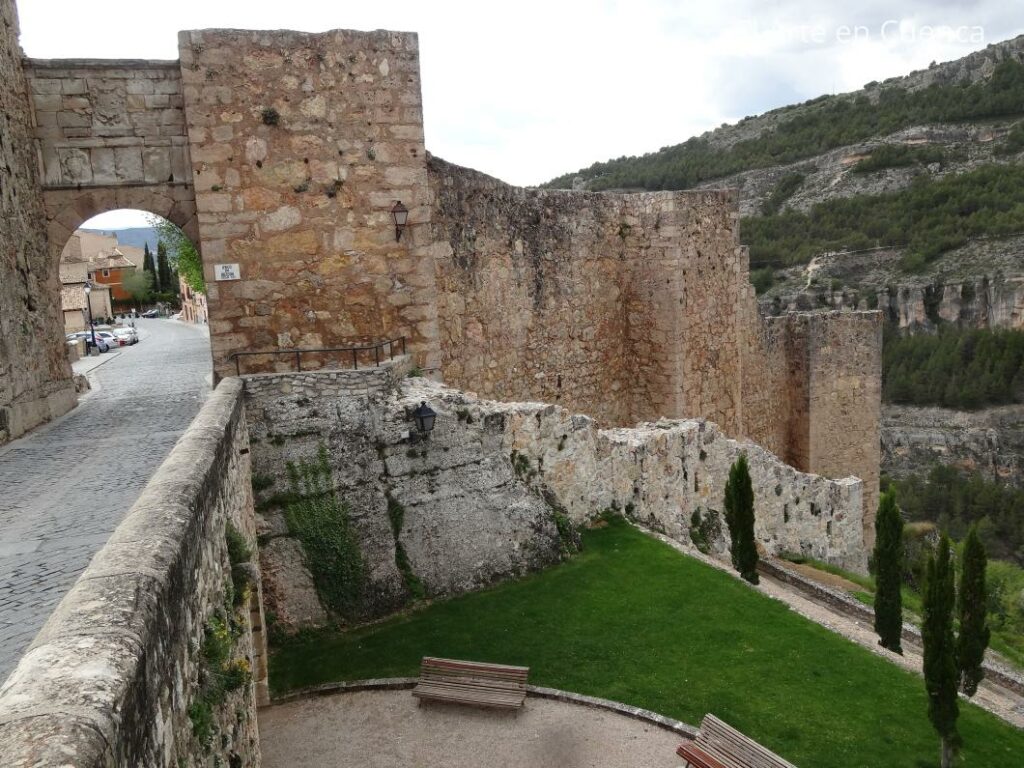
The Walls of Cuenca, built in the 10th century by the Muslims and later extended by the Christians, surround the old town of this World Heritage city. With a considerable length and several historic gates, such as the Puerta de San Juan, these walls of Spain, which are not to be missed if you visit Cuenca, offer a breathtaking view of the hanging houses and the surrounding landscapes. Cuenca’s fortifications are a testament to the city’s defensive past and a reflection of the region’s rich cultural history.
9. Walls of León
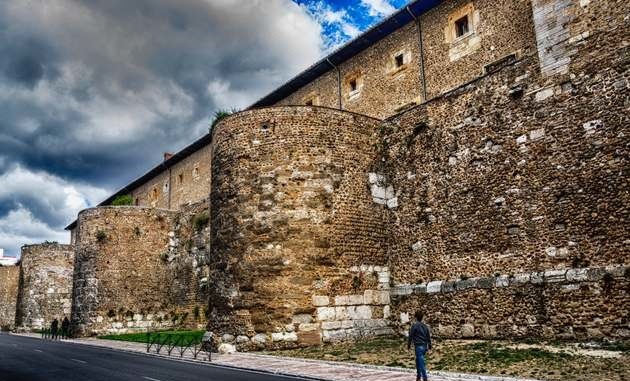
The Walls of León, initially built between the 1st and 4th centuries, are an important historical monument of the city. These unmissable walls of Spain surround the old town of León and include several historic gates and towers, such as the Torre de los Ponce. With a length of more than 2 kilometres, the walls offer a panoramic view of the cathedral and other important monuments in the city. León’s fortifications are a testament to the city’s rich history and strategic importance over the centuries. The city walls of León are a must-see on the list of the city’s must-see walls.
10. Walls of Avilés
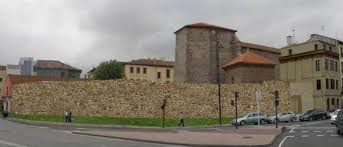
The city walls of Avilés, built in the 11th century, are one of the most important medieval fortifications in Asturias. Although a large part of the walls of Spain have disappeared, significant sections and historic gates, such as the Puerta del Mar, still remain. These unmissable walls reflect Aviles’ defensive past and its importance as a trading port. Visitors can explore the remains of the walls and enjoy a stroll through the old town, which offers a unique combination of history and modernity.
11. Walls of Zamora
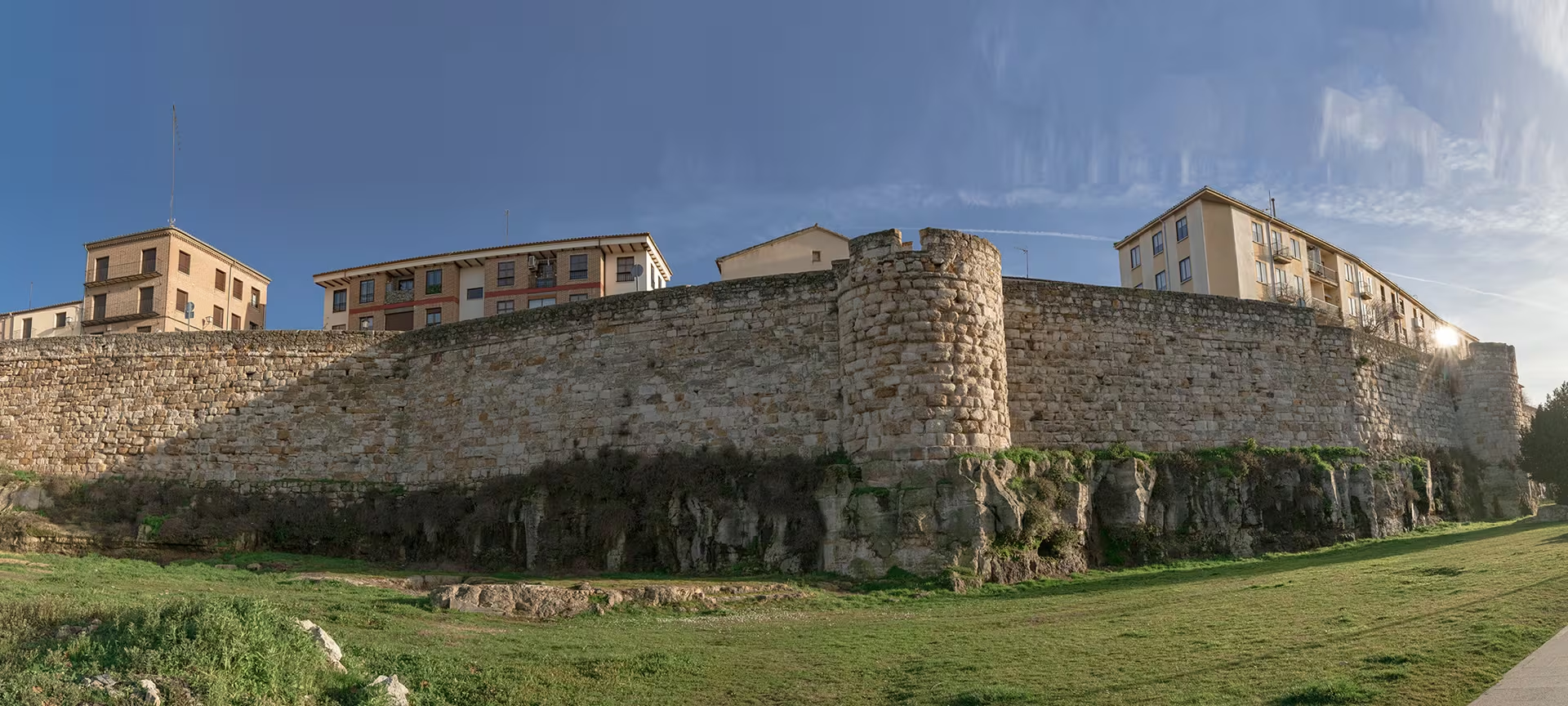
The Walls of Zamora, built in the 12th century, are an outstanding example of medieval military architecture in Castilla y León. These unmissable walls of Spain, which surround the old quarter of the city, include several monumental gates, such as the Puerta de Doña Urraca and the Puerta del Obispo. With a length of more than 2 kilometres, the walls offer stunning views of the Duero River and the surrounding area. The fortifications of Zamora are a testimony to the city’s defensive past and its strategic importance during the Reconquest.
The legend of the siege of Zamora: The walls of Zamora are deeply linked to the famous legend of the siege of Zamora, one of the most outstanding episodes in medieval Spanish history. The story goes that, after the assassination of King Sancho II, El Cid Campeador besieged the city, where his sister, the Infanta Urraca, was taking refuge. The phrase “Zamora was not won in an hour” has its origins in this siege, which lasted for months. This history makes the wall of Zamora one of the walls of Spain you cannot miss, especially if you are interested in the medieval legacy of the Iberian Peninsula.
Doña Urraca’s Gate and its legend: The wall of Zamora has several historic gates, including Doña Urraca’s Gate, named after the Infanta. According to legend, Urraca watched the siege from this gate, maintaining her firm position despite pressure to surrender the city. Although surrounded by controversy due to her role in the conflict, the figure of Urraca has remained forever linked to these walls of Spain, which are walls you cannot miss because of the historical weight they hold.
12. Walls of Girona

The Walls of Girona, which date back to Roman times and were extended in the Middle Ages, surround the old quarter of this picturesque Catalan city. More than 2 kilometres long, the walls include several historic towers and gates, such as the Torre Gironella. Visitors can walk along the wall walkway, enjoying panoramic views of the old town and surrounding countryside. Girona’s fortifications are a testament to the city’s defensive past and its strategic importance over the centuries. One of the walls of Spain that you can’t miss on the national scene.
13. Walls of Peñíscola
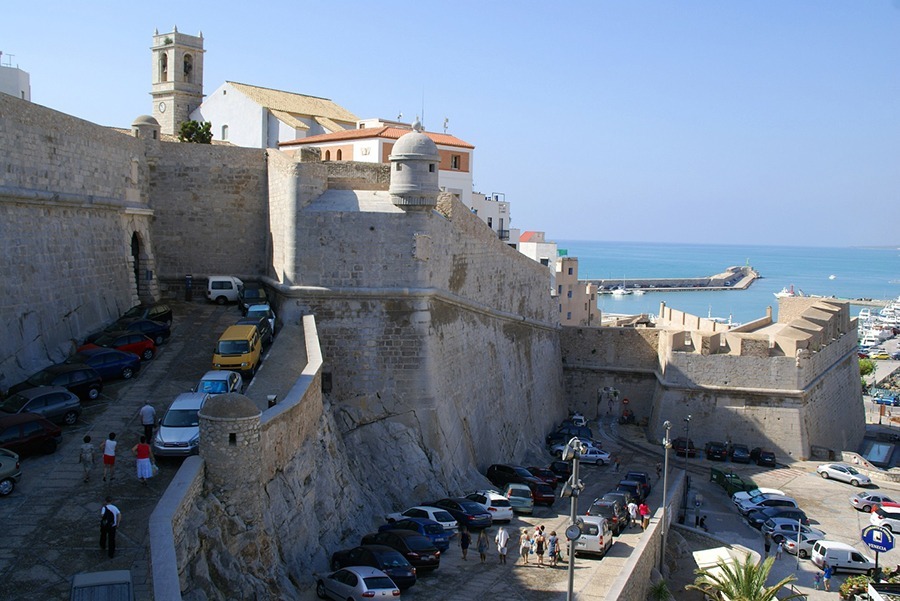
The walls of Peñíscola, built in the 13th century and reinforced by Felipe II in the 16th century, surround the old quarter of this coastal town in the Region of Valencia. These walls of Spain, which include the impressive Peñíscola Castle, offer panoramic views of the Mediterranean Sea and the surrounding countryside. The fortifications of Peñíscola are a testament to the town’s defensive past and its strategic importance as a port and refuge during wars and conflicts. Today, the walls are a popular tourist destination.
14. Walls of Plasencia
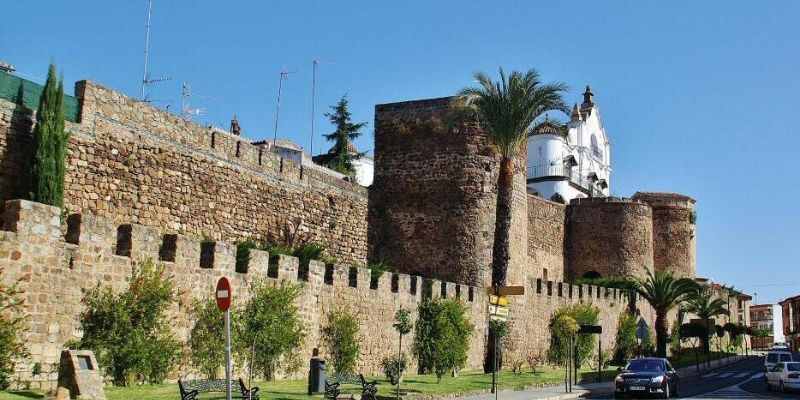
The Walls of Plasencia, built in the 13th century, surround the old quarter of this city in Extremadura. With a length of more than 2 kilometres and several historic gates, such as the Puerta de Trujillo and the Puerta del Sol, the walls reflect Plasencia’s defensive past and its strategic importance during the Middle Ages. Visitors can explore the walls and enjoy a stroll through the old town, which offers a unique combination of history and culture. Plasencia’s fortifications are a testament to the city’s rich history.
15. Walls of Cáceres

The Walls of Cáceres, built in the 12th century by the Almohads and later reinforced by the Christians, surround the old quarter of this city of Extremadura, which has been
of this Extremaduran city, declared a World Heritage Site by UNESCO. With a length of more than 1.5 kilometres, the walls include several historic towers and gates, such as the Torre de Bujaco and the Puerta de la Estrella. The fortifications of Cáceres reflect not only the city’s defensive past, but also its strategic and cultural importance over the centuries. Visitors can walk the walls and enjoy panoramic views of the old town and surrounding landscapes, as well as explore the rich history and architectural heritage that Cáceres has to offer.
The Tower of the Pulpits: This tower, which also forms part of the Cáceres city wall, is famous for its peculiar rectangular shape and curious name. Although its defensive use is evident, the name “Tower of the Pulpits” comes from the belief that from here the watchmen looked out as if they were in a pulpit, watching over the city. From the top of this tower and others you can see breathtaking views, making the walls of Cáceres a must-see for lovers of historical panoramas.
Summary
Spain’s unmissable city walls are fascinating monuments that tell stories of war, conquest and defence, bearing silent witness to a vibrant and complex past. Each of the walls mentioned in this blog not only offers a unique insight into the history and architecture of different eras, but they have also become must-see tourist destinations that attract visitors from all over the world.
These walls are not only physical structures, but also symbols of the identity and cultural heritage of their respective regions. From the impressive walls of Ávila, which offer a panoramic view of the city, to the historic walls of Cáceres, which enclose an old town full of charm and mystery, each has its own story to tell.
Exploring these walls is a way to connect with the history and culture of Spain, appreciating the engineering and construction skills of past civilisations. In addition, these fortifications offer an escape from the hustle and bustle of modern life, providing a space where you can reflect on the past and enjoy spectacular views of all the walls of Spain that are not to be missed.
We invite everyone to visit these unmissable ramparts and immerse yourself in the rich history they represent. Whether walking the ramparts of Lugo’s ramparts or exploring the historic gates of Toledo’s walls, each experience will be unique and memorable. Don’t miss the opportunity to discover “The 15 walls you can’t miss in Spain” and immerse yourself in a journey through time and history.
Exploring “The 15 walls you can’t miss in Spain” is an invitation to discover history in an interactive and immersive way. By visiting these walls, you are not only exploring a monument, but also walking along the same paths once trodden by warriors, merchants and citizens of bygone eras. Thus, every visitor becomes part of the living history that these walls continue to tell.
Remember that with DareMapp you can take a multitude of guided tours in an interactive way, including many of these “most famous routes in Spain”, a fun tour of the main destinations.
What better way than to travel and discover while learning in a fun way?





